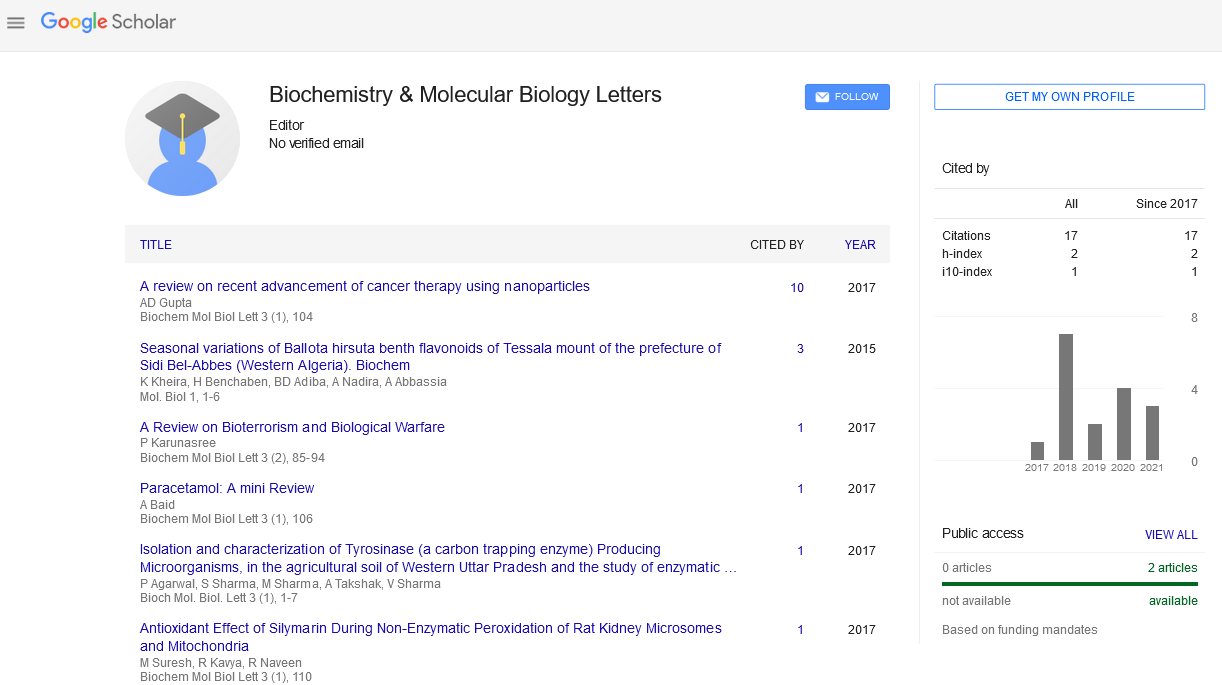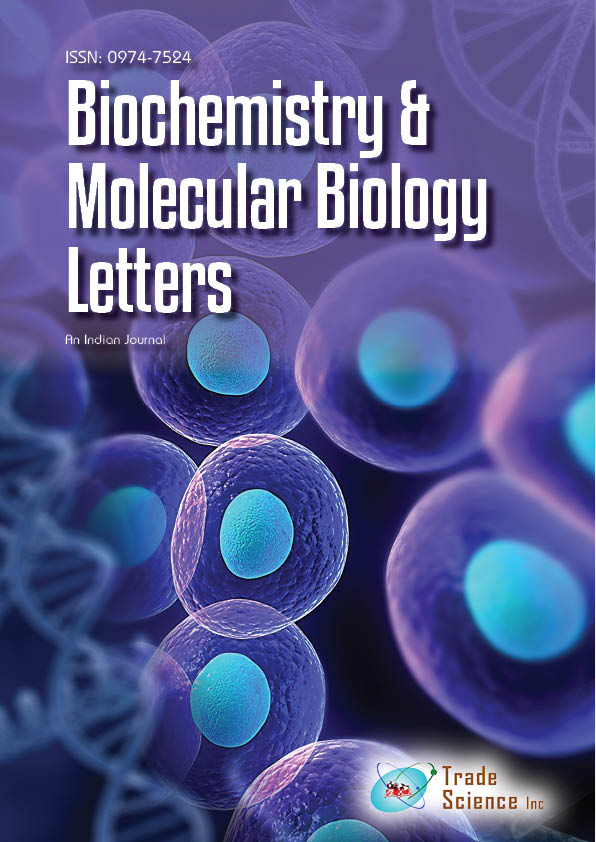Short communication
, Volume: 4( 3)The Mechanism and Consequences of Cardiac Bioenergetic Control in Cells
- *Correspondence:
- Amelia Jones, School of Medicine, University of Melbourne, Parkville, Victoria, Australia, E-mail: amelia.jones@unimelb.edu.au
Received: December 03, 2021; Accepted: December 17, 2021; Published: December 24, 2021
Citation: Jones A. The Mechanism and Consequences of Cardiac Bioenergetic Control in Cells. Biochem Mol Biol Lett. 4(3):150
Abstract
Introduction
Cardiac myocytes use ATP hydrolysis to drive key cellular processes responsible for force development and cellular ion homeostasis. When transitioning from a low to a high workload, the myocyte can match the rate of mitochondrial ATP production to a several-fold increase in ATP utilization. Ca2+ plays a crucial role in regulating and maintaining cellular metabolic homeostasis. Ca2+ gradients between the cytosol, extracellular space, and various compartmentalized spaces are a store of potential energy driven by ΔGATP. This is required for initiating many signaling pathways including regulation of mitochondrial energy supply. Inorganic phosphate-mediated feedback alone is sufficient for cardiac energetic regulation, in contradistinction to the metabolic stability theory. The hypothesis was based on an in silico study where, out of 19 other possible mechanisms, only inorganic phosphate regulation of mitochondrial respiratory complex III was capable of improving the fit of the model to data on isolated mitochondria. There is no consensus view as to what determines how mitochondrial ATP production varies to match changing demand in the cardiomyocyte. One school of thought argues that metabolite levels do not change sufficiently with changing work load to regulate ATP production, and proposes a role for calcium ions [1,2].
Mechanism and Consequences
This study's ventricular myocyte cell model is based on Crampin and Smith's work in 2006. It extends Faber and Rudy's guinea pig electrophysiological model by introducing tension development as well as pH dependence into intracellular Ca2+ homeostasis processes in 2000. To mimic the regulation of intracellular proton concentration, four acid/base transporters were introduced. Guinea pig data were utilised to validate the four acid/base transporters, in line with Faber and Rudy's (model. Ion fluxes through ion-specific channels and transporters define the electrophysiological features of the whole-cell model, and the concentrations of these ions are tracked by solving a coupled system of nonlinear ordinary differential equations (ODEs). In numerical simulations, the influence of various feedback mechanisms on energy supply regulation was investigated using the frequency-change protocol stated above to raise energy demand [3]. When all feedback mechanisms are engaged, an increase in pacing frequency causes an increase in cytosolic Ca2+ amplitude, which causes an increase in force generation and a modest drop in membrane potential amplitude. These findings show that mechanisms upstream of the respiratory chain that govern dehydrogenase flow have minimal impact on raising ATP generation to meet increased demand. Rather, only direct regulation of complex III in the respiratory chain (by Pi) has any effect on ATP generation irrespective of substrate levels, and hence on metabolite concentration stabilisation.
In order to maintain proper heart function, the management of cardiac energy supply in response to changing demand is necessary. Although a variety of suggestions have been suggested, the processes underlying this control are still unknown. We created a mathematical model of cardiac ventricular cell function in order to evaluate the effect of various probable processes in regulating cardiac energy supply in this work. Within an electrophysiological framework, the model couples thermodynamic formulations of metabolite-sensitive models of the energy-demand processes: SERCA; Na+/K+ ATPase; and cross-bridge myosin-ATPase to a model of mitochondrial oxidative phosphorylation. Found that the intrinsic substrate availability pathway (availability of ADP and Pi for ATP resynthesis) alone is capable of upregulating mitochondrial ATP production to meet increased energy demand. In striking contrast, Pi-dependent activation of mitochondrial respiratory complex III can contribute to an increase in ATP production. Ca2+ has no effect on activity or respiration rate of mitochondria. Activation of dehydrogenase flux by Ca2+ or Pi appears to have no impact on increasing ATP production rate. However, it does impact on the NADH concentration, which is an indicator of mitochondrial ATP capacity [4,5].
The increase in maximal respiration rate is in accordance with our model predictions with regard to increase in respiratory capacity. Activation of dehydrogenase fluxes cannot increase respiration rates under physiological conditions. Our model predicts that NADH concentration is not a good indicator of mitochondrial respiration rate. Contrasting experimental results on the effect of work rate on NADH levels implicitly support this notion [6]. NADH concentrations decrease with increased work in rat ventricular myocytes. Of 19 possible mechanisms, Pi regulation of respiratory complex III is the only one capable of increasing mitochondrial ATP supply above that of substrate availability.
References
- Koretsky AP, Balaban RS. Changes in pyridine-nucleotide levels alter oxygen-consumption and extra-mitochondrial phosphates in isolated-mitochondria – a P-31-NMR and NAD(P)H fluorescence study. Biochim Biophys Acta. 1987;893:398-8.
- Balaban RS. Cardiac energy metabolism homeostasis: Role of cytosolic calcium. J Mol Cell Cardiol. 2002;34:1259-71.
- Harris DA, Das AM. Control of mitochondrial ATP synthesis in the heart. Biochem J. 1991;280:561-73.
- Zhang JY, Gong GR, Ye Y, et al. Nitric oxide regulation of myocardial O-2 consumption and HEP metabolism. Am J Physiol Heart Circ Physiol. 2005;288: H310-6.
- Nakamura T, Hayashi H, Satoh H, et al. A single cell model of myocardial reperfusion injury: Changes in intracellular Na+ and Ca2+ concentrations in guinea pig ventricular myocytes. Mol Cell Biochem. 1999;194:147- 57.
- Denton, RM, Richards DA, Chin JG. Calcium-ions and the regulation of NAD+-linked isocitrate dehydrogenase from the mitochondria of rat-heart and other tissues. Biochem J. 1978;176:899-06.

